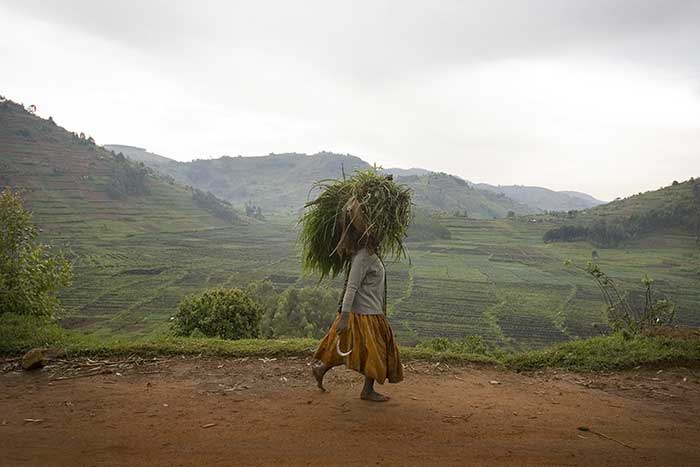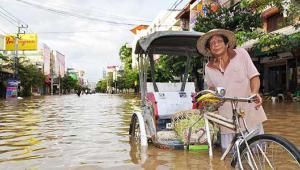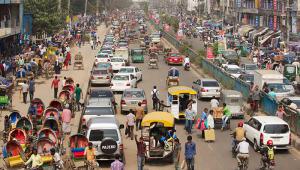web_ruralrwanda_shutterstock_242478691.jpg

Those on the front lines of climate change are usually the least able to cope with extreme weather events.
Zemada is a smallholder farmer who lives in the village of Abraha Atsbeha in Tigray, Ethiopia. Throughout her life, recurring droughts have left her and her four children teetering on the brink of chronic hunger. When one drought hit, she found herself in court, unable to pay back the small loan she had used to buy seed and fertiliser for her small plot of land.
People like Zemada, who have played no part in causing the climate crisis, are now finding themselves on its frontlines. Smallholder farmers, pastoralists, and others whose livelihoods depend on predictable weather patterns are especially vulnerable. One failed crop can wipe out years of hard work and precipitate a descent into a vicious cycle of poverty.
Right now, a number of countries – Ethiopia among them, as well as Malawi, Zambia and Zimbabwe – are at crisis point, facing a severity of drought not seen for decades. Hundreds of millions of people across India are in the grip of unprecedented heatwaves, droughts, and floods. Recently, Cyclone Winston wreaked devastation on the island of Fiji and wiped 10% off its GDP: it was the worst storm ever recorded in the southern hemisphere. These are not anomalies: they are part of a trend. Extreme weather events occurred twice as frequently during the past decade as they did in the period 1985-94.
How can financial mechanisms be deployed to tackle this ‘new normal’ of climate shocks? How should governments shift towards building resilience before disasters occur, rather than reacting afterwards, often at staggering human and economic cost? These are key questions that world leaders must address when they meet in Istanbul on 23-24 May for the first World Humanitarian Summit.
In a new report by Results UKlaunched ahead of the World Humanitarian Summit, we explore the role of insurance as one part of the solution to this problem. Risk financing mechanisms are one way for governments to harness private-sector risk capital, technology and expertise to deliver financing fast in the event of disasters and extreme weather shocks. According to one analysis, £1 invested in sovereign disaster insurance that pays out within two-four weeks can save £4 in averted humanitarian costs.
Climate risk insurance can play three critical roles in supporting vulnerable countries and communities. First, insurance acts as a safety net to provide fast payouts that can protect people from falling into poverty. Second, it provides the security needed for investment; for example, allowing a low-income farmer to access as a small loan for the first time to boost their productivity. Third, the institution of insurance across developing countries, if designed well, has the potential to incentivise risk reduction, promote data-driven risk analysis, and improve disaster preparedness.
In order to realise these benefits, however, it is crucial to recognise that insurance is not a silver bullet. It cannot work effectively as a standalone solution to the impacts of extreme weather events. Rather, it must be seen as part of a much broader approach to climate risk management. This means that public investments in risk financing should not replace, but can bolster and complement, investments in disaster risk reduction, climate adaptation, and social protection.
Some 15 developing countries have already introduced weather-based insurance programmes that target individuals directly, and some 20 have established institutional-level disaster risk financing. Innovative regional risk pools now exist in Africa, the Caribbean and the Pacific, and discussions are underway about a new risk facility for Asia. India recently announced a new nationwide ‘National Crop Insurance Scheme’, with huge ambitions of reaching 50% of the country’s farmers by 2018. In Kenya, the government has launched the ‘National Agricultural Insurance Programme’ and the ‘Kenyan Livestock Insurance Programme’ to cover small-scale farmers and herders against weather-related crop failure and loss of livestock. The Government of Ethiopia recently launched a new vegetation index-based microinsurance product, with the intention of scaling up coverage to 15 million low-income farmers by 2020.
Certain donor countries are at the forefront of this movement, notably Germany and the United Kingdom, which have spearheaded a new G7 initiative on climate risk insurance. This initiative aims to expand climate insurance coverage to an additional 400 million poor and vulnerable people by 2020, as well as to support the development of early warning systems in the most vulnerable countries.
This is an ambitious goal, and the explicit focus on reaching the poorest and most vulnerable people is laudable. But achieving it will be impossible unless donors go beyond ‘building markets’, in which the imperative is to transition schemes to commercial viability as soon as possible. Donors must be prepared to provide significant, long-term financial support to reach the most vulnerable and marginalised people that the private sector alone will not, including support to pay the premiums of the poorest.
In our report, Results UK puts forward a new set of evidence-based Pro-Poor Principles for Climate Risk Insurance: a gold standard that we want to see adopted by donors and governments as they increase their investments in risk financing. Following this principled approach, donors will be able to capitalise on the prime opportunity to expand climate risk protection to hundreds of millions of vulnerable people. Leaving it to the private sector alone won’t get the job done.
What difference can insurance make, really? Today, Zemada no longer fears the drought. She has signed up to a programme called the ‘R4 Rural Resilience Initiative’, run jointly by Oxfam America and the World Food Programme, which is built into the government of Ethiopia’s national social safety net and supported by donors. The R4 Initiative offers weather-based microinsurance to the most marginalised farmers previously considered uninsurable, as part of an integrated package together with micro-credit, micro-savings and local risk reduction activities. When drought reappeared in 2012, Zemada received a payout of 2,100 birrs (roughly £70). Nowadays, Zemada has five sheep and has expanded her farm into growing mangos. Her children no longer go hungry.













